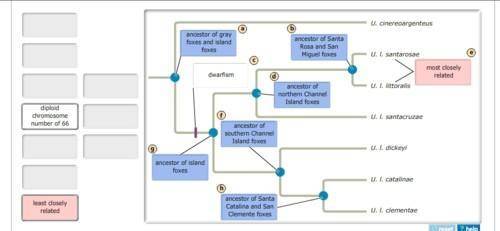
Biology, 06.05.2020 02:01 prissydizzybella5
The island fox shares a common ancestor with the gray fox, Urocyon cinereoargenteus, which is found on the mainland.
A. Both species have similar coloration and a diploid chromosome number of 66.
B. One structural difference between the two species is the reduced size of the island fox, a feature known as dwarfism.
C. The various island subspecies also differ from each other in size, number of tail vertebrae, and other characteristics.
D. The phylogenetic tree below shows the evolutionary relationships between the island fox subspecies and the gray fox.
E. Drag the labels to their appropriate locations on the tree.

Answers: 1
Another question on Biology

Biology, 21.06.2019 18:00
How did the research presented in the article affect scientists' understanding of the evolution of eukaryotes
Answers: 2

Biology, 21.06.2019 21:30
Before the can be observed by using a transmission electron microscope, cells are sliced into very thin sections. what disadvantage does this procedure present in the study of cellular parts
Answers: 1

Biology, 21.06.2019 22:00
In what for do plants utilize nitrogen? why do they need nitrogen?
Answers: 2

Biology, 22.06.2019 04:30
Why is it incorrect to say that mitochondria function only as energy factories with cell
Answers: 1
You know the right answer?
The island fox shares a common ancestor with the gray fox, Urocyon cinereoargenteus, which is found...
Questions

Mathematics, 26.01.2021 22:00


Mathematics, 26.01.2021 22:00


Mathematics, 26.01.2021 22:00

Biology, 26.01.2021 22:00



Mathematics, 26.01.2021 22:00

Computers and Technology, 26.01.2021 22:00

Physics, 26.01.2021 22:00

English, 26.01.2021 22:00







Mathematics, 26.01.2021 22:00

Biology, 26.01.2021 22:00




